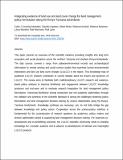| dc.contributor.author | Mustaphi, Colin | |
| dc.contributor.author | Capitani, Claudia | |
| dc.contributor.author | Boles, Oliver | |
| dc.contributor.author | Kariuki, Rebecca | |
| dc.contributor.author | Newman, Rebecca | |
| dc.contributor.author | Munishi, Linus | |
| dc.contributor.author | Marchant, Rob | |
| dc.contributor.author | Lane, Paul | |
| dc.date.accessioned | 2023-10-12T11:13:56Z | |
| dc.date.available | 2023-10-12T11:13:56Z | |
| dc.date.issued | 2019-11 | |
| dc.identifier.uri | https://doi.org/10.1016/j.ancene.2019.100228 | |
| dc.identifier.uri | https://dspace.nm-aist.ac.tz/handle/20.500.12479/2295 | |
| dc.description | This research article was published in the Anthropocene Volume 28, December 2019 | en_US |
| dc.description.abstract | This paper presents an overview of the scientific evidence providing insights into long term ecosystem and social dynamics across the northern Tanzania and southern Kenya borderlands. The data sources covered a range from palaeoenvironmental records and archaeological information to remote sensing and social science studies that examined human-environmental interactions and land use land cover changes (LULCC) in the region. This knowledge map of published LULCC research contributes to current debates about the drivers and dynamics of LULCC. The review aims to facilitate both multidisciplinary LULCC research and evidence-based policy analyses to improve familiarity and engagement between LULCC knowledge producers and end-users and to motivate research integration for land management policy formulation. Improving familiarity among researchers and non-academic stakeholders through the collation and synthesis of the scientific literature is among the challenges hindering policy formulation and land management decision-making by various stakeholders along the Kenya-Tanzania borderlands. Knowledge syntheses are necessary; yet, do not fully bridge the gap between knowledge and policy action. Cooperation across the science-policy interface is fundamental for the co-production of research questions by academics, policy makers and diverse stakeholders aimed at supporting land management decision making. For improved co-development and co-benefitting outcomes, the LULCC scientific community needs to mobilise knowledge for a broader audience and to advance co-development of relevant and meaningful LULCC products. | en_US |
| dc.language.iso | en | en_US |
| dc.publisher | Elsevier | en_US |
| dc.subject | Research Subject Categories::FORESTRY, AGRICULTURAL SCIENCES and LANDSCAPE PLANNING | en_US |
| dc.title | Integrating evidence of land use and land cover change for land management policy formulation along the Kenya-Tanzania borderlands | en_US |
| dc.type | Article | en_US |

